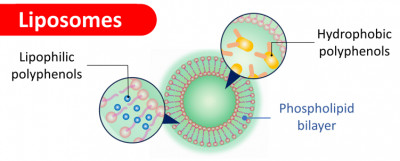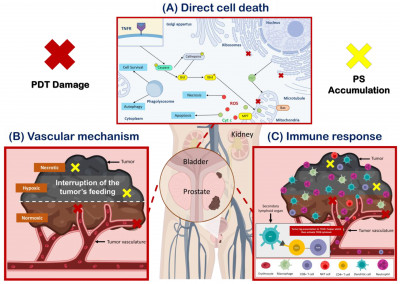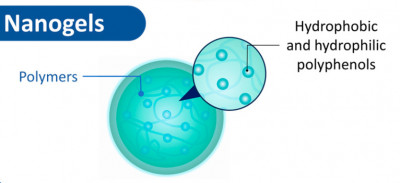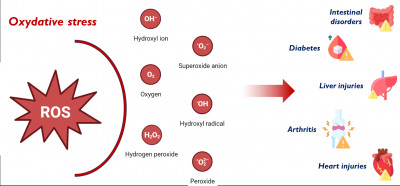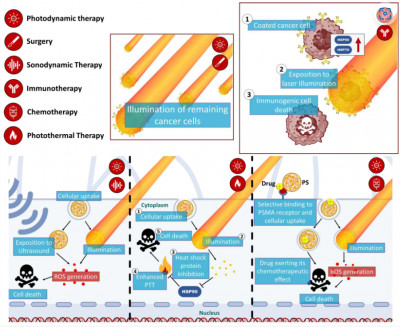This graphically simplified representation outlines different approaches for the synthesis of Polyphenol-based nanoparticles (NPs) used in various medical applications[1]:
(A) Enhanced intracellular protein delivery is achieved by complexing RNase A and polyphenols through Schiff's base reactions, followed by a secondary complexation with boronic acid polymers through reactions between boronic acids and diol-based molecules.
(B) Hydrophobic drugs are non-covalently bonded to tannic acid (TA).
(C) MMP-2-sensitive S-αPDL1/ICG nanoparticles are created by complexing αPDL1 with the photosensitizer ICG, stabilizing it with dEGCG, and compressing it with PEGylated EGCG dimer.
(D) Polyphenol-coated mesoporous silica nanoparticles (MSNs) loaded with doxorubicin (DOX) are developed for targeted cancer treatment. EGCG-modified MSNs are used for drug delivery, with DOX loaded into the MSNs through noncovalent adsorption. An amine-terminated DNA aptamer ensures physiological stability and controlled drug release.
(E) Den−DOX−TA−Fe3+ (DDTF) nanocomplexes are fabricated for delivering DOX to the nuclei by coating the DOX−Den complex with TA−Fe3+ metal–polyphenol networks.
07 Sep 2023
Medical illustration of clindamycin-resistant group B Streptococcus bacteria.
Disease Control and Prevention (CDC)
11 Aug 2023
Plant cells, unlike animal cells, have rigid cell walls made of cellulose, providing support and protection. They contain a nucleus containing DNA, chloroplasts for photosynthesis, a central vacuole for storage and turgor pressure, mitochondria for energy production, and various organelles like the endoplasmic reticulum and Golgi apparatus for cellular processes. Plasmodesmata facilitate communication between cells.
05 Jun 2024
(A) Utilizing Boronic Acid-Decorated Polymers for Intracellular Protein Delivery with Polyphenols. Polyphenols play a critical role in enhancing the interaction between polymers containing boronic acid and proteins. In an acidic environment, the pH-responsive catechol–boronate bonds form between the boronic acid-conjugated polymers and polyphenols, enabling the controlled release of RNase. This release can induce cell death by selectively targeting and degrading specific RNA molecules [1].
(B) Enhancing Chemodynamic Therapy (CDT) through the DOX−Den Complex with TA−Fe3+ MPN. The DOX−Den complex efficiently transports doxorubicin (DOX) into cancer cells while evading drug efflux transporters on the cell membrane. Within the cells, DOX is transported to the cell nuclei through the Fenton reaction-mediated CDT. This process leads to the generation of an excess of reactive oxygen species (ROS), ultimately resulting in the elimination of drug-resistant cancer cells [1].
(C) Combining Immune Checkpoint Blockade and Photodynamic Therapy using MMP-2-Sensitive PEGylated EGCG Dimers. PEGylated EGCG dimers and EGCG dimers are utilized to facilitate a novel approach that combines immune checkpoint blockade with photodynamic therapy. Upon activation by MMP-2, the nanoparticles release αPD-L1/ICG, with the antibody effectively blocking the PD-L1 checkpoint. Simultaneously, illumination of the photosensitizer induces multiple effects, including the generation of reactive oxygen species (ROS) and cell death. This innovative approach holds promise for cancer treatment [1].
08 Sep 2023
The scheme proposed for the synthesis of nanoproducts extracellularly by using secreted products of Trichoderma is shown [1]. Through the scientific extrapolation of the mentioned literature, and through noting the role of these metabolites in increasing the nanoparticles (NPs) properties toward plant pathogens, researchers can assume that active metabolites secreted from the biocontrol agent Trichoderma are responsible for capping off the NPs in the process of synthesis and provide more stable and safe nanomaterials in a sustainable way.
12 Sep 2023
Mesoporus silica nanoparticles-coated polyphenols and their localization.
06 Sep 2023
Escherichia coli (E. coli), Pseudomonas aeruginosa, and Staphylococcus aureus are three bacteria of significant importance in microbiology and healthcare. E. coli, a gram-negative bacterium, resides in the human intestine and serves as a model organism for genetic research. However, certain pathogenic strains can cause gastrointestinal and urinary tract infections. Pseudomonas aeruginosa, another gram-negative bacterium, is highly adaptable and often found in various environments. It poses a challenge due to its antibiotic resistance and causes opportunistic infections, particularly in immunocompromised individuals. Staphylococcus aureus, a gram-positive bacterium, inhabits the skin and mucous membranes and can lead to a range of infections, from skin issues to severe conditions like bloodstream infections. Understanding these bacteria is crucial for managing and preventing associated diseases, including antibiotic-resistant strains.
04 Sep 2023
Artemisia herba alba, also known as "Desert Wormwood" or "White Sagebrush," is a medicinal plant native to North Africa, including Morocco. This remarkable herb has gained attention for its potential beneficial effects on various health conditions, including liver injury, diabetes, heart disease, and arthritis. With a long history of traditional use and ongoing scientific research, Moroccan Artemisia herba alba holds promise as a natural remedy for promoting overall well-being and managing these health concerns.
04 Sep 2023
(A) The initiation of cell death through various pathways is contingent upon the location of the photosensitizer (PS) and the degree of organelle damage. Photodynamic therapy (PDT)-induced damage to mitochondria results in the loss of membrane permeability and the release of pro-apoptotic factors. Conversely, damage to the endoplasmic reticulum (ER) leads to the release of stored cellular calcium deposits. Furthermore, lysosomal damage results in the release of proteolytic enzymes upon illumination and can also trigger autophagy. In instances where apoptosis is impaired, necrosis and autophagy may emerge as the primary mechanisms of cell death following PDT. It is noteworthy that multiple PSs may localize in different organelles, potentially leading to the concurrent activation of multiple cell death pathways (adapted from Mroz, P et al. [1]).
(B) Photodynamic therapy has the capacity to induce vascular damage, disrupting the tumor's blood supply and causing its demise through various mechanisms.
(C) Photodynamic therapy can also activate innate and adaptive immunity, eliciting a systemic antitumor immune response and ultimately eradicating tumor cells.
06 Sep 2023
Possible mechanisms of action to induce prostate cancer eradication by targeting several pathways involving oxidative stress, cell death and cell cycle arrest.
[1]
07 Sep 2023
Therapeutic approaches for colorectal cancer, with conventional treatment (i.e., surgery, radiation, hormone therapy, targeted therapy, and chemotherapy), as well as the use of flavonoids, tannins, and non-flavonoids in colorectal cancer treatment [1].
06 Sep 2023
Oxidative stress is a physiological condition characterized by an imbalance between reactive oxygen species (ROS) production and the body's antioxidant defense mechanisms. ROS, including superoxide anion, hydrogen peroxide, and hydroxyl radicals, can be generated by various cellular sources, such as mitochondria, peroxisomes, and NADPH oxidase.
04 Sep 2023
Laboratory mice play a pivotal role in advancing biomedical research by serving as invaluable models for studying human physiology, diseases, and potential treatments. Their genetic similarity to humans and the ease with which their genes can be modified make them indispensable. Researchers use mice to replicate human diseases, from cancer to Alzheimer's, enabling investigations into disease mechanisms and the development of therapeutic interventions. Additionally, mice are crucial for drug testing, helping identify promising candidates while reducing risks in clinical trials. Their contributions extend to genetics, immunology, neuroscience, toxicology, and reproductive biology, underpinning countless scientific discoveries that improve human health and medical treatments.
14 Sep 2023
Oxidative stress is a complex physiological condition characterized by an imbalance between the production of reactive oxygen species (ROS) and the body's ability to detoxify them or repair the resulting damage. This imbalance can have far-reaching consequences on various organ systems, including the liver, pancreas, cardiovascular system, and joints.
04 Sep 2023
Under the microscope, a butterfly wing reveals a mesmerizing tapestry of scales, each overlapping like shingles on a roof. These scales, which are the source of a butterfly's vibrant colors and patterns, come in various shapes and sizes—some are elongated and narrow, while others are broader and more rounded. The scales are arranged in neat rows and can exhibit iridescent colors due to the microscopic structure that reflects and refracts light, a phenomenon known as structural coloration.
Each scale is intricately textured, with ridges and grooves running along its length, which contribute to the diffraction of light and the creation of shimmering, multi-colored effects. The scales themselves may be translucent or opaque, and their coloration can range from vivid blues and greens to deep reds and blacks, often with intricate patterns that are not visible to the naked eye.
Between the scales, the wing's underlying membrane can sometimes be seen, a delicate structure that supports the entire wing. The fine detail and vibrant colors of a butterfly wing under the microscope provide a glimpse into the complex beauty and adaptability of these delicate insects.
09 Aug 2024
In prostate cancer treatment, Photodynamic Therapy (PDT) is being explored in combination with various modalities [1]. PDT coupled with surgery, particularly salvage radical prostatectomy after vascular-targeted PDT (VTP), shows promise for treating recurrent or persistent cancer. While PDT alongside Sonodynamic Therapy (SDT) is a developing area, preclinical studies suggest its potential in damaging cancer cell membranes through sensitizers. PDT with Photoimmunotherapy (PIT) induces antitumor immune responses and selectively destroys cancer cells, especially when targeting specific markers like prostate-specific membrane antigen (PSMA). Innovative Photochemotherapy, merging PDT and chemotherapy, offers selective drug delivery to tumor cells, supported by in vivo studies [2][3][4]. Photothermal Therapy (PTT), a heat-based phototherapy, complements PDT by improving local blood flow and oxygen levels in tumor tissues, albeit with challenges in material efficiency. These diverse PDT combinations signify evolving prospects in prostate cancer treatment.
07 Sep 2023
Water bears, or tardigrades, are microscopic creatures known for their incredible survival skills. Despite their tiny size, they can endure extreme environments, from the vacuum of space to intense radiation, heat, and cold. Discover how these resilient organisms thrive in conditions that would be lethal to most other forms of life, and learn why they’re often called “the toughest creatures on Earth.” Explore their unique survival mechanisms in our infographic!
Encyclopedia Editorial Office
13 Nov 2024
A mammoth water snake welcoming the research team in the flooded Bottomland Hardwood Forest at Russel Sage Wildlife Management Area in Northeast Louisiana.
08 Mar 2024
 Encyclopedia
Encyclopedia





